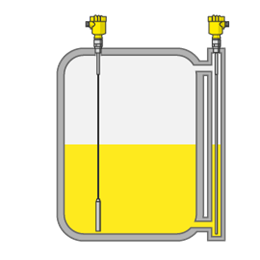Sensors: guided wave radar
Also known as TDR
Radar measurement with benefits
**So, you're planning something more sophisticated than a dip stick to take tank measurements. But no-one told you there were so many types of gauge / sensor. Which do you choose?**
Perhaps you like the radar sensor, but worry that it will not perform in your case. Here we focus on a possible solution.

Guided wave radar / TDR (time domain reflectometry) sensors
This gauge is fitted in the roof of the tank like a regular radar sensor. It also uses the principle of emitting a very short burst of microwaves and measuring the time it takes for the echo to return.
In TDR, however, a rod or cable extends vertically into the liquid or bulk solid to channel the radar pulse. This means that TDR sensors are not non contact, although they do offer some advantages.

How Vegaflex guided wave radar sensors can be fitted in a bypass tube
Bypass tubes and TDR
A TDR gauge offers the option of using a bypass tube to measure height. This is not possible with a regular open air radar sensor, which reads any echo including those from walls, ridges and struts, making readings in an enclosed space difficult. TDR doesn't have this problem, even when there is build up or corrosion on the bypass tube walls.
The access nozzle for TDR can also be smaller than that required for open air radar, perhaps as small as 5cm.
Radar for diesel
Another advantage is that TDR can be applied to diesel. Some substances, including diesel, have a low dielectric constant (relative permittivity), meaning that radar passes straight through them. Because TDR registers a change in dielectric constant it is reliable in a way that regular radar sensors aren't.
Measuring the interfaces between liquids
You may have two liquids in a tank where the dielectric constant of the upper liquid is lower than that of the one below, such as oil on water. TDR can pick up the heights of both substances, since not all of the pulse is absorbed by the upper liquid, although be careful when measuring in the presence of water vapour or steam since its high dielectric constant can obscure your level readings.
Connecting to HyDip
One thing to remember, however, is that whichever sensor you've installed it's as easy as wiring up a block plug and snapping it into place on your HyDip device to get it talking to your laptop. Read more about HyDip online tank management here.
Which gauge for you?
Selecting the right gauge for your situation can require discussion and thought. Cost, suitability, ease of installation and accuracy are just some of the factors that figure in a decision.
As well as guided wave radar / TDR gauges your choices include:
Updated less than a minute ago
